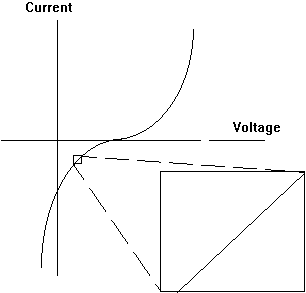Electrochemistry–A Linear System?
Electrical circuit theory distinguishes between linear and non-linear systems (circuits). Impedance analysis of linear circuits is much easier than analysis of non-linear ones.
The following definition of a linear system is taken from Signals and Systems by Oppenheim and Willsky1A.V Oppenheim and A.S. Willsky, Signals and Systems, 2nd ed., Prentice-Hall, 1996.:
A linear system … is one that possesses the important property of superposition: If the input consists of the weighted sum of several signals, then the output is simply the superposition, that is, the weighted sum, of the responses of the system to each of the signals. Mathematically, let y1(t) be the response of a continuous time system to x1(t) ant let y2(t) be the output corresponding to the input x2(t). Then the system is linear if:
1) The response to x1(t) + x2(t) is y1(t) + y2(t)
2) The response to ax1(t) is ay1t) …
For a potentiostated electrochemical cell, the input is the potential and the output is the current. Electrochemical cells are not linear! Doubling the voltage does not necessarily double the current.
However, it is possible to have pseudo-linear electrochemical systems. When you look at a small enough portion of a cell’s current-versus-voltage curve, it seems to be linear.

In normal EIS practice, a small (1 to 10 mV) AC signal is applied to the cell. The signal is small enough to confine you to a pseudo-linear segment of the cell’s current-versus-voltage curve. You do not measure the cell’s nonlinear response to the DC potential because in EIS you only measure the cell current at the excitation frequency.
If the system is non-linear, the current response contains harmonics of the excitation frequency.
Some researchers have made use of this phenomenon. Linear systems should not generate harmonics, so the presence or absence of significant harmonic response allows one to determine the system’s linearity. Other researchers have intentionally used larger amplitude excitation potentials. They use the harmonic response to estimate the curvature in the cell’s current voltage curve.

Comments are closed.